Embark on a culinary journey through Bali’s rich and diverse food landscape.

Bali, often referred to as the “Island of the Gods,” is a paradise not just for its stunning beaches and vibrant culture but also for its delectable cuisine. The island’s food scene is a melting pot of flavors, influenced by Indonesian, Chinese, and Indian culinary traditions. Whether you’re a food enthusiast or a casual traveler, exploring Balinese cuisine is a must-do on your trip.
In this ultimate guide, we’ll delve into the top 15 local dishes you must try in Bali. From mouth-watering street food to exquisite restaurant offerings, get ready to tantalize your taste buds and immerse yourself in the island’s rich culinary heritage.
Table of Contents
-
- 4. Lawar
-
- 7. Gado-Gado
-
- 8. Sate Plecing
-
- 10. Tipat Cantok
-
- 12. Jaje Laklak
-
- 13. Soto Babi
- 16. Conclusion
1. Nasi Goreng (Fried Rice)
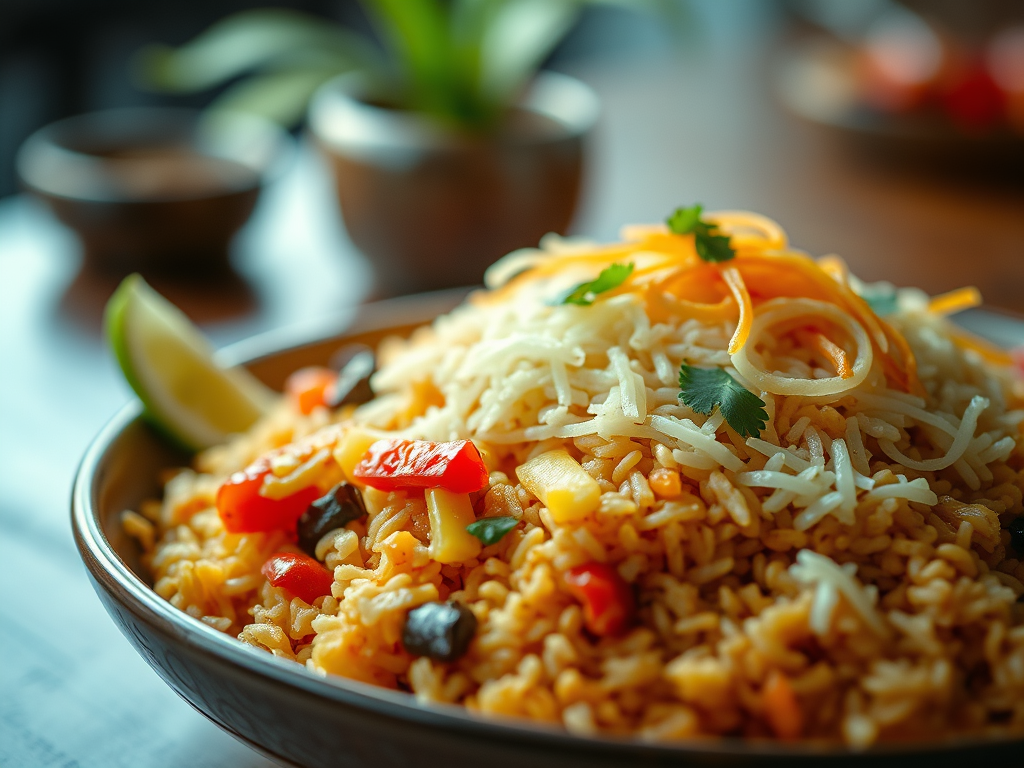
What Is It?
Nasi Goreng is Indonesia’s take on fried rice, considered by many as the country’s national dish. It consists of rice stir-fried with a mixture of sweet soy sauce (kecap manis), shallots, garlic, tamarind, and chili, often accompanied by other ingredients like shrimp, chicken, or beef.
Why You Should Try It
- Flavorful and Versatile: The combination of sweet, spicy, and savory flavors makes it a delightful meal any time of the day.
- Local Favorite: It’s a staple in Balinese households and widely available in both street stalls and upscale restaurants.
Where to Try
- Warung Indonesia in Kuta: Affordable and authentic.
- Made’s Warung in Seminyak: A popular spot among tourists and locals alike.
2. Babi Guling (Suckling Pig)

What Is It?
Babi Guling is a traditional Balinese dish featuring a whole suckling pig roasted on a spit over an open fire. The pig is stuffed with a blend of spices like turmeric, coriander seeds, lemongrass, black pepper, and garlic, giving it a rich and aromatic flavor.
Why You Should Try It
- Cultural Experience: Traditionally served during ceremonies, it’s a dish deeply rooted in Balinese culture.
- Unique Flavor Profile: The crispy skin and tender meat offer a delightful contrast.
Where to Try
- Ibu Oka in Ubud: Famous for its Babi Guling.
- Warung Babi Guling Pak Malen in Seminyak: A local favorite.
3. Satay Lilit (Minced Seafood Satay)

What Is It?
Satay Lilit is a Balinese twist on the classic satay. Instead of skewering chunks of meat, minced seafood (usually fish) is mixed with coconut milk and spices, then wrapped around lemongrass sticks and grilled.
Why You Should Try It
- Aromatic Delight: The lemongrass sticks infuse the meat with a citrusy aroma.
- Healthy Option: Lean seafood makes it a lighter alternative to meat satays.
Where to Try
- Bumbu Bali Restaurant in Tanjung Benoa: Offers cooking classes as well.
- Jimbaran Seafood Cafés: Enjoy fresh seafood right on the beach.
4. Lawar

What Is It?
Lawar is a traditional Balinese salad made from a mix of vegetables, coconut, minced meat, and rich spices. There are various versions, including Lawar Merah (red, with animal blood) and Lawar Putih (white, without blood).
Why You Should Try It
- Authentic Taste: Offers a true taste of Balinese home cooking.
- Complex Flavors: The blend of spices and textures is a treat for the palate.
Where to Try
- Local Warungs: For the most authentic experience.
- Warung Wardani in Denpasar: Known for its excellent Lawar.
5. Bebek Betutu (Slow-Cooked Duck)

What Is It?
Bebek Betutu is a dish where a whole duck is stuffed with a mix of traditional Balinese spices, wrapped in banana leaves and coconut husks, then slow-cooked for up to 24 hours.
Why You Should Try It
- Tender and Flavorful: The slow-cooking process makes the meat incredibly tender.
- Cultural Significance: Often prepared for special occasions and ceremonies.
Where to Try
- Bebek Bengil (Dirty Duck Diner) in Ubud: Famous for its duck dishes.
- Bebek Tepi Sawah in Ubud: Dine with a view of rice paddies.
6. Nasi Campur Bali (Balinese Mixed Rice)
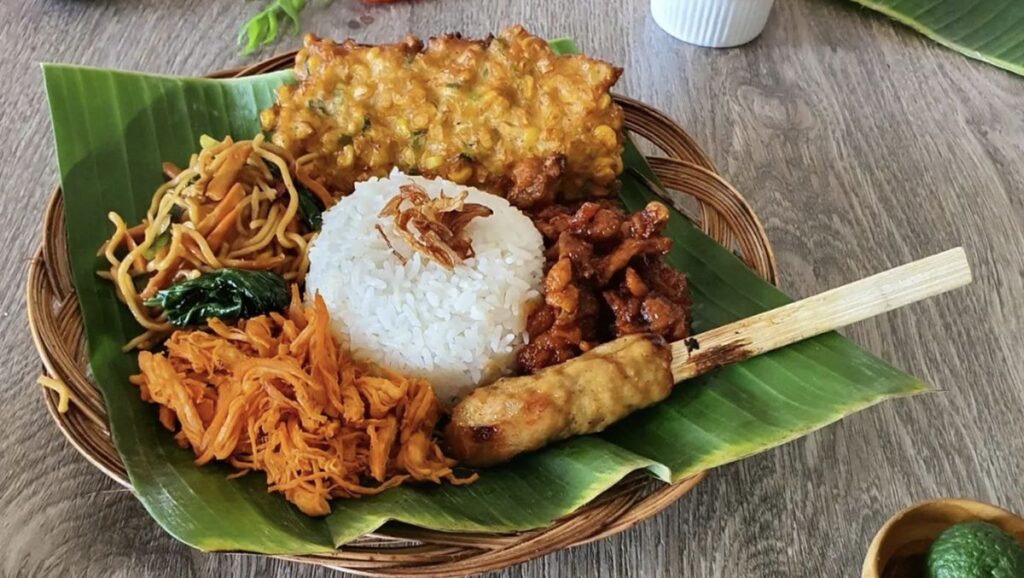
What Is It?
Nasi Campur Bali is a plate of white rice served with an assortment of Balinese side dishes like meats, vegetables, peanuts, eggs, and sambal.
Why You Should Try It
- Variety: Perfect for those who want to sample multiple dishes at once.
- Balanced Meal: Offers a good mix of proteins, carbs, and vegetables.
Where to Try
- Warung Nasi Ayam Kedewatan Ibu Mangku in Ubud.
- Nasi Bali Men Weti in Sanur: Popular among locals.
7. Gado-Gado
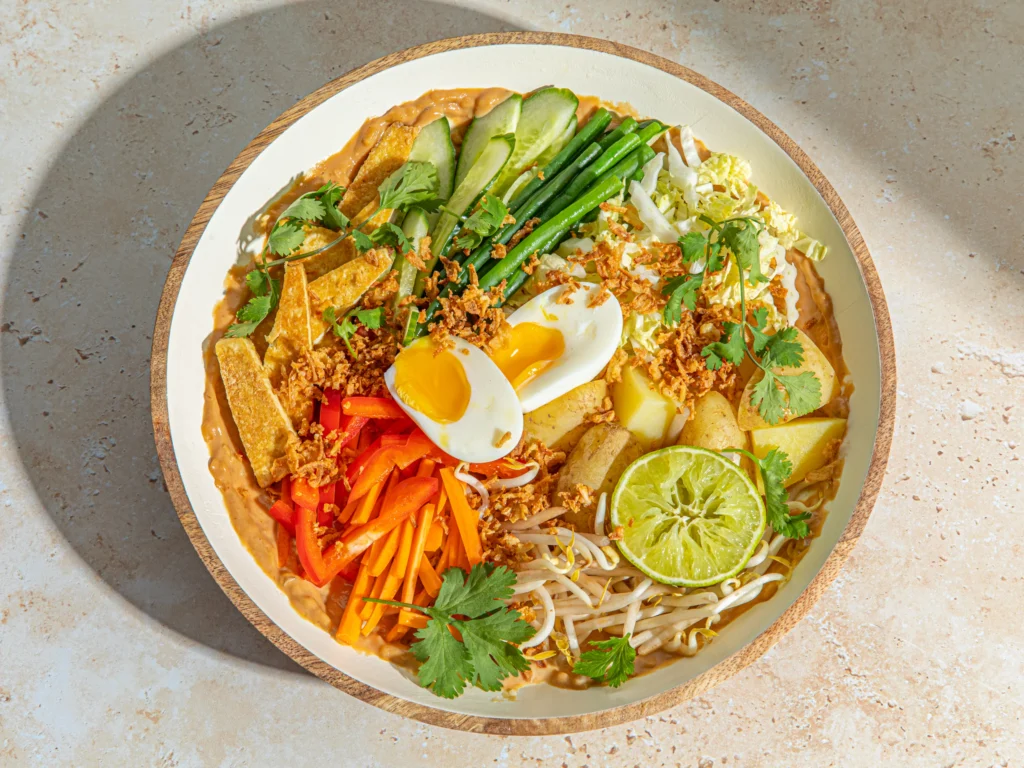
What Is It?
Gado-Gado is an Indonesian salad comprising boiled vegetables, tofu, tempeh, hard-boiled eggs, and lontong (rice cakes), all drizzled with a rich peanut sauce.
Why You Should Try It
- Vegetarian-Friendly: A great option for vegetarians and vegans.
- Delicious Peanut Sauce: The star of the dish that ties all the elements together.
Where to Try
- Warung Pojok in Kuta: Offers authentic Indonesian dishes.
- Biah Biah in Ubud: Known for its traditional fare.
8. Sate Plecing
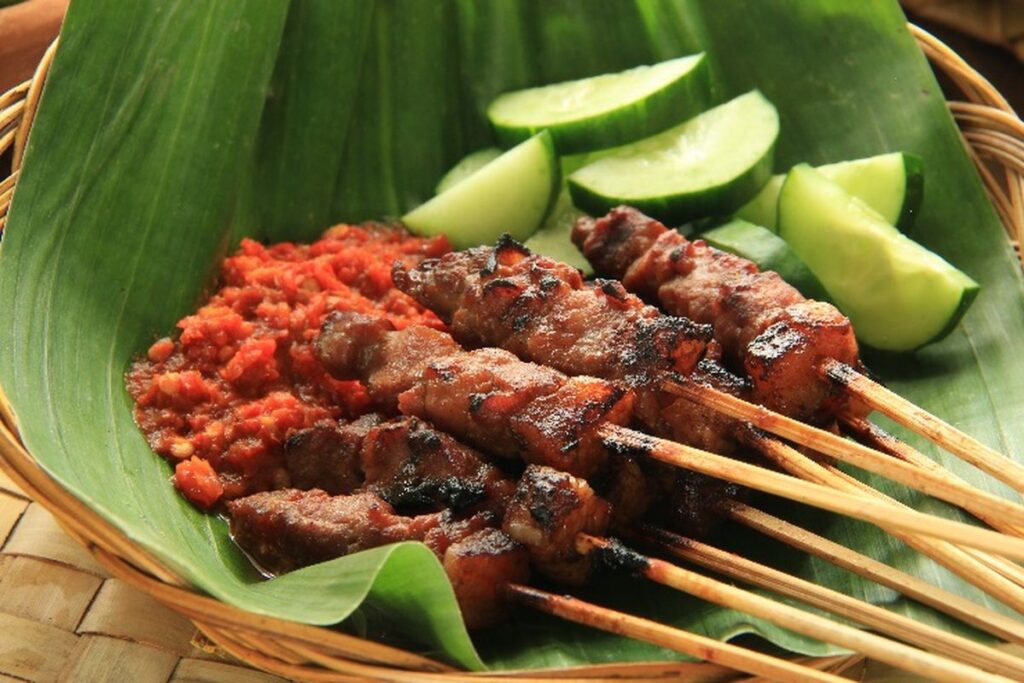
What Is It?
Sate Plecing is grilled meat skewers served with a spicy plecing sauce made from chilies, tomatoes, and shrimp paste.
Why You Should Try It
- Spicy Kick: Ideal for those who love spicy food.
- Unique Sauce: The plecing sauce sets it apart from other satays.
Where to Try
- Warung Plecing Arjuna in Denpasar.
- Local Night Markets: For an authentic experience.
9. Pisang Goreng (Fried Banana)

What Is It?
Pisang Goreng is a popular Indonesian snack made by deep-frying bananas in batter until golden and crispy.
Why You Should Try It
- Sweet Treat: Perfect for dessert or a midday snack.
- Versatile: Often served with honey, palm sugar syrup, or ice cream.
Where to Try
- Street Vendors: Best enjoyed fresh from the fryer.
- Anomali Coffee in Seminyak: Pairs well with their coffee.
10. Tipat Cantok
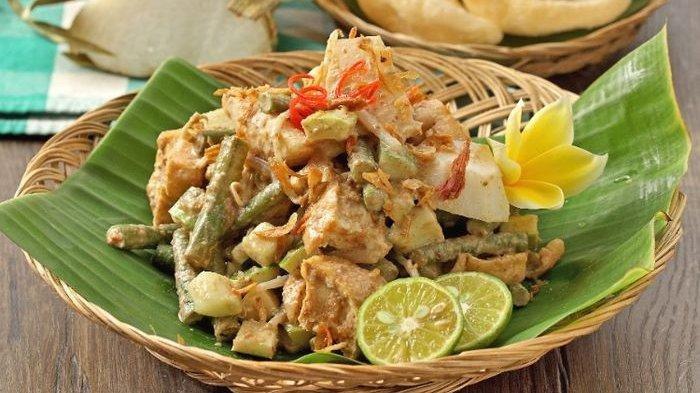
What Is It?
Tipat Cantok is a traditional Balinese dish made of compressed rice cakes (tipat) mixed with boiled vegetables and topped with a peanut sauce.
Why You Should Try It
- Healthy Choice: A light and nutritious meal.
- Local Favorite: Commonly eaten by locals, offering an authentic taste.
Where to Try
- Warung Cantok in Denpasar.
- Local Markets: Freshly prepared in the mornings.
11. Es Campur (Mixed Ice Dessert)

What Is It?
Es Campur is a refreshing dessert made from shaved ice mixed with various ingredients like coconut, jelly, avocado, jackfruit, and sweet syrup.
Why You Should Try It
- Beat the Heat: Perfect for Bali’s tropical climate.
- Colorful and Fun: A feast for both the eyes and the palate.
Where to Try
- Street Vendors: Especially near beaches.
- Warung Ice Bali in Denpasar.
12. Jaje Laklak

What Is It?
Jaje Laklak are small, traditional Balinese rice flour cakes cooked in a special clay mold, often served with grated coconut and palm sugar syrup.
Why You Should Try It
- Unique Texture: Soft and slightly chewy.
- Cultural Experience: Often made during traditional ceremonies.
Where to Try
- Traditional Markets: Like Ubud Market.
- Local Ceremonies: If you have the opportunity.
13. Soto Babi
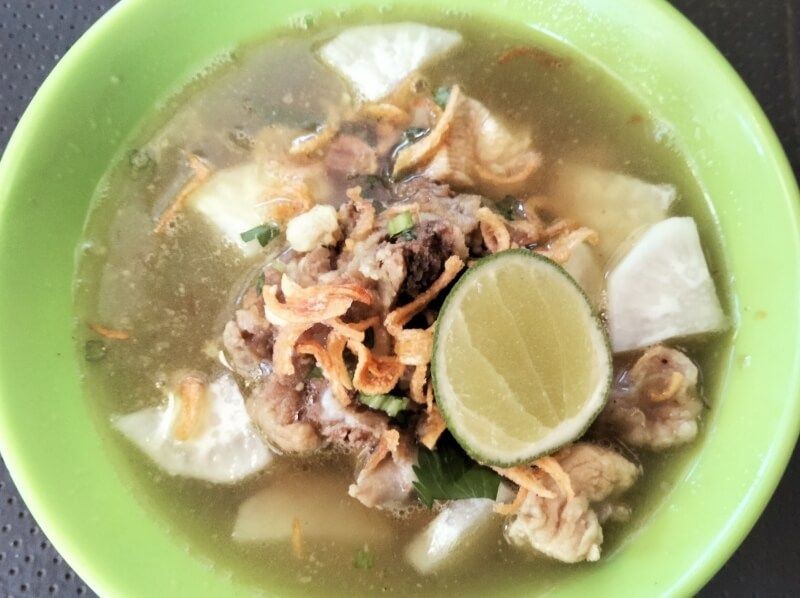
What Is It?
Soto Babi is a Balinese pork soup with a rich, savory broth flavored with spices like turmeric, ginger, and lemongrass.
Why You Should Try It
- Comfort Food: Warm and hearty, ideal for dinner.
- Flavorful Broth: A depth of flavor that is both soothing and satisfying.
Where to Try
- Soto Babi Bawah Pohon in Kuta.
- Local Warungs: For an authentic taste.
14. Martabak Manis (Sweet Pancake)

What Is It?
Martabak Manis is a thick, sweet pancake filled with various ingredients like chocolate, cheese, peanuts, and condensed milk.
Why You Should Try It
- Indulgent Dessert: Perfect for those with a sweet tooth.
- Variety of Fillings: Customize it to your liking.
Where to Try
- Martabak Berlin in Denpasar.
- Street Food Stalls: Especially in the evenings.
15. Bubur Injin (Black Rice Pudding)

What Is It?
Bubur Injin is a traditional Balinese dessert made from black glutinous rice cooked slowly with coconut milk and palm sugar.
Why You Should Try It
- Unique Flavor: The nutty black rice pairs wonderfully with the sweetness of palm sugar.
- Cultural Significance: Often served during traditional ceremonies.
Where to Try
- Cafe Wayan & Bakery in Ubud.
- Biah Biah Café in Ubud.
Conclusion
Bali’s culinary scene is as diverse and vibrant as its culture. From savory dishes like Babi Guling and Nasi Goreng to sweet delights like Pisang Goreng and Bubur Injin, there’s something to satisfy every palate. Exploring these dishes is not just about eating but also about immersing yourself in the rich traditions and stories that each dish carries.
Final Tips:
- Try Local Warungs: Small local eateries often offer the most authentic flavors.
- Be Adventurous: Don’t hesitate to try dishes you’re unfamiliar with.
- Respect Local Customs: Some dishes are traditionally eaten with hands; feel free to do so respectfully.
Ready to Explore More of Bali?
Check out our other guides on Treasure Bali for more tips on making the most of your Balinese adventure.



